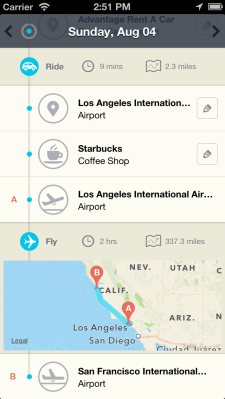Have you had one of those moments where you wondered, “Damn, what did I actually do this weekend?” Or maybe where you couldn’t think of the name of that awesome restaurant you visited last week? A new iPhone app called Rove might help you remember.
The app was created by the company behind social travel service Zetrip, which wasn’t getting enough traction, according to co-founder and CEO Edouard Tabet. Rove was initially designed to address one of Zetrip’s shortcomings — Zetrip pulled social data from Facebook friends to provide “travel inspiration,” but there were lots of gaps.
“[With social data] you can’t reconstruct this whole experience, and [users] couldn’t remember where they went, even though we tried to make it very simple,” Tabet said. “So we decided, ‘Let’s try to automate that process.'”
In other words, Rove pulls GPS data from your iPhone to create a full record of where you’ve been. Once you turn the app on, it’s basically working in the background and requires no additional work from the user, although you can edit the locations, as well as add photos (either directly from your iPhone camera or from social networks) and comments. At the end of the day, or the week, or whatever, you can open the app and see the record that’s been created for you.
And while the initial inspiration for the app was travel, there’s no reason this can’t be used in your daily life — for example, when Tabet demonstrated the app, he showed me the record of his day, including his commute from the Rove office to the TechCrunch office.
The Rove team has put a lot of work into minimizing battery usage, he said — basically, it can detect your activity level, so if you’re staying in one place the app should be fairly inactive, and “the more you move the more we take measurements.” There are other nice touches, like the fact that Rove distinguishes between moments when you’re in transit and when you’re stationary (so if you drive from Palo Alto to San Francisco, it won’t try to convince you that you were actually spending time in one of the cities that you passed through on your drive).
Tabet also emphasized Rove’s approach to privacy, saying that while you can share records for a given period of time over email, Facebook or Twitter, nothing gets posted automatically. (In contrast the similar-sounding life-logging app Saga recently added automated sharing features, and it’s taking more of a social network-style approach, albeit with plenty of privacy controls.)
I tried the app out over the weekend, and the experience isn’t quite as seamless as I’d hoped. Apparently the app shut down after about a day of use, probably because I restarted my phone, meaning that I didn’t record any data for Sunday. (Tabet said that in iOS 7, it should be easier to automatically restart the app.) Also, the app guessed incorrectly about a number of the locations. Still, the editing process was quick and painless, and regardless of some inaccuracies, having the automatic record was pretty cool. And the battery drain wasn’t noticeable.
Tabet said he isn’t focused on making money yet, but he expects the business model to involve advertising and affiliate links when records are shared. So if I use Rove to tell friends about the great hotel I stayed at over the weekend and they make a reservation of their own, Rove could get a cut.
You can download the Rove app here.
